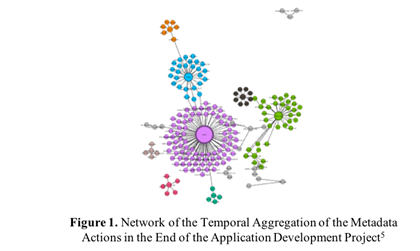Master Assignment Service and cyber-security (SCS)
metadata analysis on low-code development platforms: network science approach
Type: Master CS or Master BIT
Period: 2019 - 2020
Student:
If you are interested please contact :
Dr. Marten van Sinderen (SCS), m.j.vansinderen@utwente.nl
Dr. Maria Iacob (IEBIS), m.e.iacob@utwente.nl
Participating organizations:
eMagiz (with the help of two UT Supervisors and an International Research Team).
Background:
Platform-as-a-Service (PaaS) or Low-Code Development Platform is the signature of a paradigm shift in software development. Simply it embraces the very idea of model-driven software development that employs a number of essential principles such as abstraction, model transformation and refinement, model reusability[1]. That is, the idea has existed for more than 20 years, but its realization is about to begin along with low-code platforms by game-changing players including Salesforce, Mendix, Outsystems.
These platforms provide citizen developers with a cloud-based integrated development environment (Cloud-IDE) that foster rapid application development via a glossary and services. There are hundreds of metadata actions and services to choose from on a typical platform. This means that almost every metadata action that the developer could potentially select to create an artifact and/or link artifacts the developer does not select. Or, almost every possible link between the artifacts is non-link, it is not registered in the digital trace data; so, the data collected by PaaS platforms in this respect is sparse; as opposed to dense data in a world where every software artifact is linked with each other.
It is this sparseness that calls for Network Science approach to analysis of metadata actions on platforms. Many systems can be regarded as networks, sets of things and their interactions. In a graphic representation of a network, nodes (or vertices) are the things of interest, and interacting nodes are joined in pairs by arcs (or links). A network is a mathematical object specifically designed to represent sparse data, and network science is concerned with analyzing and modeling such systems. We can regard the sparse data of recorded the metadata actions on the platform database as a network (see Figure 1).

eMagiz is the Model Driven Hybrid Integration Platform (HIP) and Managed Services (Managed Integration) to integrate your business: easy, agile & fast. For user of the platform this means:
- Easy. Based on models, forget code.
- Agile. Integration Lifecycle Management as a Service.
- Fast. Component re-use based on patterns.
Every 2 weeks there is a new platform release with new features and improvements. To inform, educate and help the platform users multiple channels of communication are used, for example platform documentation, community blogs and community newsletters.
Assignment:
This master project targets Network Science Approach to low-code development platforms can significantly contribute to understanding of model-driven software development and to progress of disruptive cloud technologies. The endeavors for employing network science approach to software systems are valuable, but only limited to only complex software code. Conduct a research if Network Science Approach is feasible to low-code development platforms and deliver possible areas of improvement.
Goals:
1. Discovering graph models which can describe best the digital trace data. It is to decide on the type of network representation of metadata action patterns (i.e., creating or connecting software artefacts).
2. Associating graph models to metamodel. Existence of a metamodel that describes overall modeling elements on PaaS is essential to understand an extent to which graph model fits to the metamodel
Key results:
- Analysis of Digital Trace Data, Metadata, Metamodel
- Exploratory network analysis to identify the structure of the network
- Search for signature patterns in terms of correlations
- Network Construction Prototype on existing integration models
Scope:
Limited to a specific set of the multiple integration patterns offered by the hybrid integration platform.
Based on the provided background multiple thesis assignments are possible to define. For example a network based on traced metadata prototype or graph model reference architecture. In an intake meeting with us you could define a concrete assignment meeting our requirements.
Duration: 20 to 28 weeks
We expect the following deliverables:
- Research relevant science literature
- Investigate current state
- Define a solution design
- Build a prototype
- Validate findings in a real case business environment with help of prototype
- Report findings in a paper
Requirements:
As the project requires close cooperation on daily bases with stakeholders, fluent English. Familiarity with IT architectures and programming is preferable. Affinity towards IT and any form of process mapping is a plus.
Knowledge and Skills to be exploited and enhanced further:
- Software Engineering Area: Architecture, Metamodel and language, Software Quality,
- Network Science: Complex Systems, Dynamic and Structural Network Analysis, Graph Theory
- Data Science and Technologies: iGraph in R, Gephi, Data Visualization, Machine Learning
- Management Science: Data Products, Analytics for Monitoring and Fostering Performance
Location & timing:
We are looking for a student who can start first of November 2019. The location (workplace) will be at eMagiz and CAPE Groep (Enschede).
Outputs:
-Thesis with high impact and international visibility
- Prospective career future in Business: Low-Code Software Development Platform
- Prospective career future in Research: PhD in Business Information Systems
- Contemporary Research and Engineering Skills in Data Science, Complexity Systems, Emerging Technologies
More information:
If you’re interested in graduating at CAPE Groep, visit our website www.werkenbijcape.nl/afstuderen-bij-cape/ for more information. Here you can also apply for a thesis assignment by sending your application and resumé. Or contact one of the UT supervisors mentioned at the top of this page, or the CAPE Groep advisor for this assignment Pieter Verkroost, p.verkroost@capegroep.nl.
